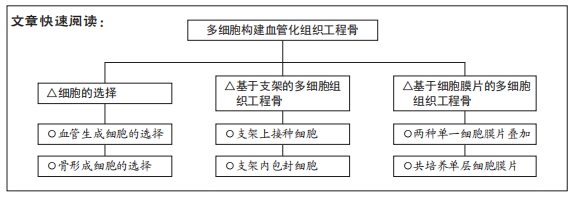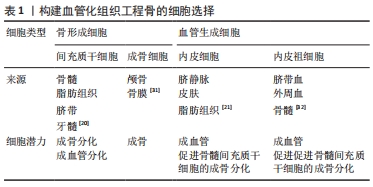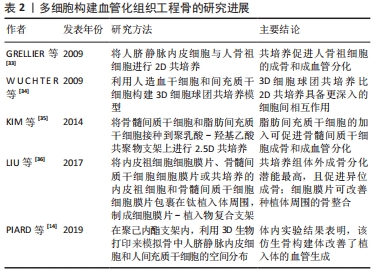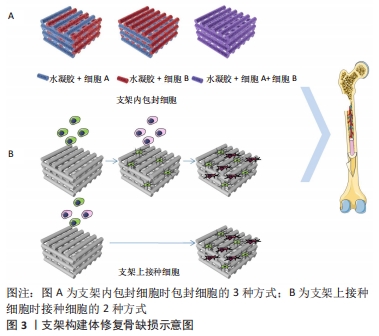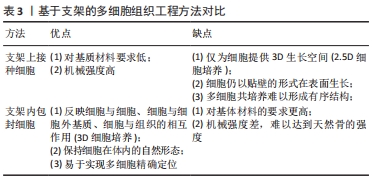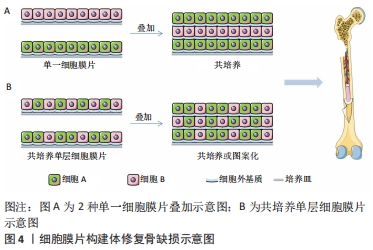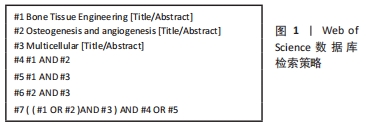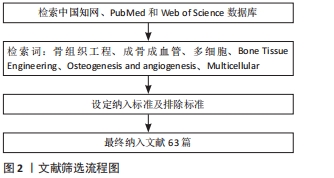[1] BOEHRNSEN F, PETRA M, MAREIKE N, et al. Cotransplantation of mesenchymal stromal cells and endothelial cells on calcium carbonate and hydroxylapatite scaffolds in vivo. J Craniomaxillofac Surg. 2021; 49(3):238-245.
[2] SHI R, HUANG YL, MA C, et al. Current advances for bone regeneration based on tissue engineering strategies. Front Med. 2019;13(2):160-188.
[3] OWAKI T, SHIMIZU T, YAMATO M, et al. Cell sheet engineering for regenerative medicine:current challenges and strategies. Biotechnol J. 2014;9(7):904-914.
[4] SAFINSHA S, MUBARAK AM. Composite scaffolds in tissue engineering. Mater Today Proc. 2020;24:2318-2329.
[5] GREEN H, KEHINDE O, THOMAS J. Growth of cultured human epidermal cells into multiple epithelia suitable for grafting. Proc Natl Acad Sci U S A. 1979;76(11):5665-5668.
[6] YORUKOGLU CA, KITER EA, AKKAYA S, et al. A Concise review on the use of mesenchymal stem cells in cell sheet-based tissue engineering with special emphasis on bone tissue regeneration. Stem Cells Int. 2017; 2017:2374161.
[7] GALLICO G, COMPTON C, KEHINDE O, et al. Cultured epithelial autografts for giant congenital nevi. Plast Reconstr Surg. 1990;84:1-9.
[8] IWASAKI K, WASHIO K, MEINZER W, et al. Application of cell-sheet engineering for new formation of cementum around dental implants. Heliyon. 2019;5:e01991.
[9] ORCIANILM M, MILENA F, ROBERTO DP, et al. Biofabrication and bone tissue regeneration: cell source, approaches, and challenges. Front Bioeng Biotechnol. 2017;5:17-32.
[10] YE LIN P, KIWON P, JAE MIN C. 3D-bioprinting strategies based on in situ bone-healing mechanism for vascularized bone tissue engineering. Micromachines. 2021;12(3):287-310.
[11] GUREL PG, TORUN KOSE G, HASIRCI V. Influence of co-culture on osteogenesis and angiogenesis of bone marrow mesenchymal stem cells and aortic endothelial cells. Microvasc Res. 2016;108:1-9.
[12] TAKAHISA A, CHI CHUN P, ALEXANDER S, et al. Vascularized bone-mimetic hydrogel constructs by 3d bioprinting to promote osteogenesis and angiogenesis. Int J Mol Sci. 2019;20(5):1096-1201.
[13] SILVA AS, SANTOS LF, MENDES MC, et al. Multi-layer pre-vascularized magnetic cell sheets for bone regeneration. Biomaterials. 2020;231: 119664.
[14] PIARDA C, JEYARAMA A, YI L, et al. 3D printed HUVECs/MSCs cocultures impact cellular interactions and angiogenesis depending on cell-cell distance. Biomaterials. 2019;222:119423.
[15] AKBARI A, JABBARI N, SHARIFI R, et al. Free and hydrogel encapsulated exosome-based therapies in regenerative medicine. Life Sci. 2020; 249:1-12.
[16] WENG YM, WANG ZF, SUN JW, et al. Engineering of axially vascularized bone tissue using natural coral scaffold and osteogenic bone marrow mesenchymal stem cell sheets. Arch Biochem Biophys. 2021;50:1-8.
[17] TORRESA AL, BIDARRA SJ, VASCONCELOS DP, et al. Microvascular engineering: dynamic changes in microgel-entrapped vascular cells correlates with higher vasculogenic/angiogenic potential. Biofabrication. 2020;228:119554.
[18] MA JL, SANNE K, YANG F, et al. Concise review:cell-based strategies in bone tissue engineering and regenerative medicine. Stem Cells Transl Med. 2014;3(1):98-107.
[19] DIOMEDE F, MARCONI GD, FONTICOLI L, et al. Functional relationship between osteogenesis and angiogenesis in tissue regeneration. Int J Mol Sci. 2020;21(9):32-42.
[20] AMLER AK, THOMAS A, TUZUNER S, et al. 3D bioprinting of tissue-specific osteoblasts and endothelial cells to model the human jawbone. Sci Rep. 2021;11(1):4876.
[21] ZHANG HL, ZHOU YL, ZHANG W, et al. Construction of vascularized tissue-engineered bone with a double-cell sheet complex. Acta Biomater. 2018;77:212-227.
[22] PRZEKORAL A, VANDROVCOVA M, TRAVNICKOVA M, et al. Evaluation of the potential of chitosan/ beta-1,3-glucan/hydroxyapatite material as a scaffold for living bone graft production in vitro by comparison of ADSC and BMDSC behaviour on its surface. Biomed Mater. 2017; 12(1):015030.
[23] WANG Z, HAN L, SUN T, et al. Construction of tissue-engineered bone with differentiated osteoblasts from adipose-derived stem cell and coral scaffolds at an ectopic site. Br J Oral Maxillofac Surg. 2020;59:46-51.
[24] STORTI G, SCIOLI MG, KIM BS, et al. Adipose-derived stem cells in bone tissue engineering: useful tools with new applications. Stem Cells Int. 2019; 2019:3673857.
[25] ZHANG JH, WEHRLE E, ADAMEK PA, et al. Optimization of mechanical stiffness and cell density of 3D bioprinted cell-laden scaffolds improves extracellular matrix mineralization and cellular organization for bone tissue engineering. Acta Biomater. 2020;11:307-322.
[26] TROUNSON A, DEWITT ND. Pluripotent stem cells progressing to the clinic. Nat Rev Mol Cell Biol. 2016;17(3):194-200.
[27] RONG Q, Li SY, ZHOU Y, et al. A novel method to improve the osteogenesis capacity of hUCMSCs with dual-directional pre-induction under screened co-culture conditions. Cell Prolif. 2020;53(2):e12740.
[28] MUTSCHALL H, WINKLER S, WEISBACH V, et al. Bone tissue engineering using adipose-derived stem cells and endothelial cells: effects of the cell ratio. J Cell Mol Med. 2020;24:7034-7043.
[29] SHEN QH, FAN XT, JIANG ML, et al. Inhibiting expression of Cxcl9 promotes angiogenesis in MSCs-HUVECs coculture. Arch Biochem Biophys. 2019;675:108-119.
[30] COLLINS MN, REN G, YOUNG K, et al. Scaffold Fabrication Technologies and Structure/Function Properties in Bone Tissue Engineering. Adv Funct Mater. 2021;12:47309-47319.
[31] MA J, BOTH SK, YANG F, et al. Concise review: cell-based strategies in bone tissue engineering and regenerative medicine. Stem Cells Transl Med. 2014;3:98-107.
[32] URBICH C, DIMMELER S. Endothelial progenitor cells functional characterization. Trends Cardiovasc Med. 2004;14:318-322.
[33] GRELLIER M, TOJAIS NF, BOURGET C, et al. Role of vascular endothelial growth factor in the communication between human osteoprogenitors and endothelial cells. J Cell Biochem. 2009;106:390-398.
[34] WUCHTER PMD, SAFFRICH R, LUDWIG A, et al. Cellular interaction between human mesenchymal stem cells and hematopoietic stem cells in 2D-and 3D-culture-systems. Blood. 2009;114(22):1442.
[35] KIM K, PARK S, IM G. Osteogenic differentiation and angiogenesis with cocultured adipose-derived stromal cells and bone marrow stromal cells. Biomaterials. 2014;35:4792-4804.
[36] LIU H, ZHOU W, REN N, et al. Cell sheets of co-cultured endothelial progenitor cells and mesenchymal stromal cells promote osseointegration in irradiated rat bone. Sci Rep. 2017;7(1):3038-3050.
[37] ROMANAZZO S,MOLLEY TG, NEMEC S, et al. Synthetic bone‐like structures through omnidirectional ceramic bioprinting in cell suspensions. Adv Funct Mater. 2021;31(13):1-13.
[38] MOBARAKI M, GHAFFARI M, YAZDANPANAH A, et al. Bioinks and Bioprinting: a Focused Review. Bioprinting. 2020;18:e00080.
[39] GEORGOPOULOU A, PAPADOGIANNIS F, BATSALI A, et al. Chitosan/gelatin scaffolds support bone regeneration. J Mater Sci Mater Med. 2018;29(5):59-72.
[40] SINGHL R, EITLERL D, MORELLE R, et al. Optimization of cell seeding on electrospun PCL-silk fibroin scaffolds. Eur Polym J. 2020;134:109838-109849.
[41] LIVERANI L, RAFFEL N, FATTAHI A, et al. Electrospun patterned porous scaffolds for the support of ovarian follicles growth:a feasibility study. Sci Rep. 2019;9(1):1150-1164.
[42] LIVERANI L, LACINA J, JUDITH AR, et al. Incorporation of bioactive glass nanoparticles in electrospun PCL/chitosan fibers by using benign solvents. Bioact Mater. 2018;3(1):55-63.
[43] THEIN HW, HOCKIN HK. Prevascularization of a gas-foaming macroporouscalcium phosphate cement scaffold via coculture of human umbilical vein endothelial cells and osteoblasts. Tissue Eng Part A. 2013;19(15-16):1675-1685.
[44] SUN P, ZHANG QQ, NIE W, et al. Biodegradable mesoporous silica nanocarrier bearing angiogenic QK peptide and dexamethasone for accelerating angiogenesis in bone regeneration. ACS Biomater Sci Eng. 2019;5(12):6766-6778.
[45] LIVERANI L, KILLIAN MS, BOCCACCINI AR. Fibronectin functionalized electrospun fibers by using benign solvents: best way to achieve effective functionalization. Front Bioeng Biotechnol. 2019;7(68):1-9.
[46] JOSHI A, ZHE X, IKEGAMI Y, et al. Co-culture of mesenchymal stem cells and human umbilical vein endothelial cells on heparinized polycaprolactone/gelatin co-spun nanofibers for improved endothelium remodeling. Int J Biol Macromol. 2020;151:186-192.
[47] JANITHA M, UNAGOLLA AC, UNAGOLLA J. Hydrogel-based 3D bioprinting: a comprehensive review on cell-laden hydrogels, bioink formulations, and future perspectives. Appl Mater Today. 2020;18:1-22.
[48] BYAMBAA B, ANNABI N, YUE K, et al. Bioprinted osteogenic and vasculogenic patterns for engineering 3D bone tissue. Adv Healthc Mater. 2017;6(16):1-15.
[49] SHAO L, GAO Q, XIE CQ, et al. Directly coaxial 3D bioprinting of large-scale vascularized tissue constructs. Biofabrication. 2020;12(3):035014.
[50] MOBARAKI M, GHAFFARI M, YAZDANPANAH A, et al. Bioinks and bioprinting: a focused review. Bioprinting. 2020;18:e00080.
[51] PIARD CM, YU C, FIAHER JOHN PY. Cell-laden 3D printed scaffolds for bone tissue engineering. Clin Rev Bone Miner Metab. 2015;13(4):245-255.
[52] PIARD C, BAKER H, Kamalitdinov T, et al. Bioprinted osteon-like scaffolds enhance in vivo neovascularization. Biofabrication. 2019; 11(2):025013.
[53] CHEN YW, SHEN YF, HO CC, et al. Osteogenic and angiogenic potentials of the cell-laden hydrogel/mussel-inspired calcium silicate complex hierarchical porous scaffold fabricated by 3D bioprinting. Mater Sci Eng C Mater Biol Appl. 2018;91:679-687.
[54] SAKAGUCHI K, SHIMIZU T, OKANO T. Construction of three-dimensional vascularized cardiac tissue with cell sheet engineering. J Control Release. 2015;205:83-88.
[55] KWON OH, KIKUCHI A, YAMATO M, et al. Rapid cell sheet detachment from poly[N-isopropylacrylamide]-grafted porous cell culture membranes. J Biomed Mater Res. 2015;50:82-89.
[56] SAKAI Y, KOIKE M, HASEGAWA H, et al. Rapid fabricating technique for multi-layered human hepatic cell sheets by forceful contraction of the fibroblast monolayer. PLoS One. 2019;8(7):e70970.
[57] PANDUWAWALA CP, ZHAN X, DISSANAYAKA WL, et al. In vivo periodontal tissue regeneration by periodontal ligament stem cells and endothelial cells in three-dimensional cell sheet constructs. J Periodontal Res. 2017;52(3):408-418.
[58] IMASHIRO C, SHIMIZU T. Fundamental Technologies and Recent Advances of Cell-Sheet-Based Tissue Engineering. Int J Mol Sci. 2021; 22(1):425-443.
[59] LU YZ, ZHANG WJ, WANG J, et al. Recent advances in cell sheet technology for bone and cartilage regeneration:from preparation to application. Int J Oral Sci. 2019;11(2):17-30.
[60] HIRONOBU T, TERUO O. Cell sheet-based tissue engineering for organizing anisotropic tissue constructs produced using microfabricated thermoresponsive substrates. Adv Healthc Mater. 2016;4(16):2388-2407.
[61] 邢飞,段鑫,刘明,等.外周血来源间充质干细胞/内皮祖细胞复合细胞膜片的构建及其生物学特性初步研究[J].中国修复重建外科杂志, 2020,34(1):109-115.
[62] 周震,王亚敏,任飞,等.骨髓间充质干细胞膜片和脐静脉内皮细胞共培养模型的构建及鉴定[J].中国组织工程研究,2019,23(25): 3951-3955.
[63] XU M, LI JD, LIU XN, et al. Fabrication of vascularized and scaffold-free bone tissue using endothelial and osteogenic cells differentiated from bone marrow derived mesenchymal stem cells. Tissue Cell. 2019;61: 21-29.
|
